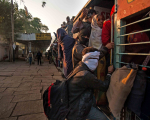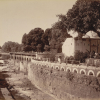I live in the suburbs of Kolkata and trains are a big part of my life. I take a commuter train every day to reach Howrah station. Train networks in India operate on a certain hierarchy. While the suburban trains take daily commuters to nearby destinations, the passenger trains go to the same destinations but with fewer stops and faster service. Long-distance travellers catch the ‘express’ trains that traverse the length and breadth of India, jostling for time and space with the ‘superfast’ trains, such as Shatabdi, Duronto and Rajdhani, that can speed up to 150 km/hr and get highest priority on the railway network.
On the opposite end of the hierarchy, there are one-off passenger trains that operate on arterial branches to remote destinations. These phantom trains either run through difficult terrain, or on routes which are not very busy, or on tracks that haven’t yet been updated to broad gauge like the rest of the network, instead running on rails a meter apart (meter gauge) or just two feet apart (narrow gauge). Some time ago I had the opportunity to travel on a narrow gauge route from Katwa to Balgona, both part of Bardhaman district, West Bengal, on the Burdwan-Katwa Railway (BKR). This short route of 53 km was built and operated as part of McLeod’s Light Railways, which opened to traffic on December 1, 1915. Operating at a maximum speed of 30 km/hr, the BKR was a revolutionary mode of conveyance in the early 20th century, but a century later the BKR is now the slowest transport on the road.
I was struck by how different the experience on the BKR journey was from my regular commute. I researched more on narrow gauge train routes in India, and found out about the Gwalior-Sheopur NG Passenger train (52172), which was once part of Gwalior Light Railway (GLR), run by the Gwalior State in British India. It continues to operate as the longest narrow gauge route in the world, connecting Gwalior to Sheopur, a distance of 210 km, which it covers in 11 hours. The train was the brainchild of Maharaja Madho Rao Scindia, and the Gwalior-Sheopur line was completed in 1909. Another thing that caught my imagination was the route it takes through the Chambal region bordering Madhya Pradesh and Rajasthan. The badlands of Chambal, infamous for being a lawless, harsh landscape, were the refuge of outlaws—the ‘Wild West’ of India. It brought back memories of Bollywood-Spaghetti Western movies and the exploits of legendary brigands and dacoits like Phoolan Devi, Maan Singh, Paan Singh Tomar, Malkhan Singh and Sultana Daku. I knew I had to take this train route once.
On a long weekend in January 2016, I flew to Delhi and then took the road to Gwalior. Next day I was at Gwalior Junction station at 5:30 am. I was advised to get there early if I wanted a seat, but it seemed I wasn’t early enough. The seven coaches, with a capacity of 150–200 passengers each, were already full. My co-passengers helped me board and made some room for me. The train didn’t have much by way of amenities—the seats were hard, made of wood or metal, and there were no toilets.
The train left Gwalior at 6:30 am, and the next stop was Ghosipura where another trainload of people boarded. I wondered how all those people would get on because there was hardly any standing space inside the compartments. They made their way on to the carriage roof or hung on to the sides of the train. I went up to the driver’s cabin where Anwar Khan, the driver, let me ride with him for a bit. Later he helped me climb to the carriageway roof. It was as crowded as the coach below, but again, I was accommodated. My co-passengers told me to watch out for branches to avoid getting gashed.
The train dragged along at an excruciatingly slow speed of 20 km/hr, stopping at 26 stations along the way. Reasons for the extreme slow pace of the train could be poor maintenance of the tracks, given the high operational costs, and frequent derailments. However, the people I met had a kind of resigned forbearance about the slow nature of the journey.
One of the other little joys of travelling in the remote interiors of India is to note the fantastic names of nondescript stations like Bamour Gaon, Jora Alapur, Dantarda Kalan, Tarra Kalan, Ikdori and Kaimar Kalan. I asked them why they took the train and got to know that their villages weren’t well connected by roads. And even where there were roads, taking the bus was expensive compared to the train.
Though it has its industrial heritage value, the narrow gauge train is a relic in today’s fast-paced world. Keeping up with the changing times, the Railway Ministry has already upgraded two narrow gauge lines—the Gwalior-Bhind and Gwalior-Shivpuri lines—to broad gauge lines. With their upgradation, the Gwalior-Sheopur line is the last remaining narrow gauge line of the Gwalior Light Railway still in operation. The line will soon cease to exist once the broad gauge upgrading is completed, for which purpose the Railway Ministry has sanctioned a budget of 1,200 crores. I had mixed feelings when I heard about the upgrade plans. On the one hand, travel will become a lot more convenient for all these people and bring about a positive change in their lives, but on the other hand it will be the end of an era in the history of rail travel in India.
















